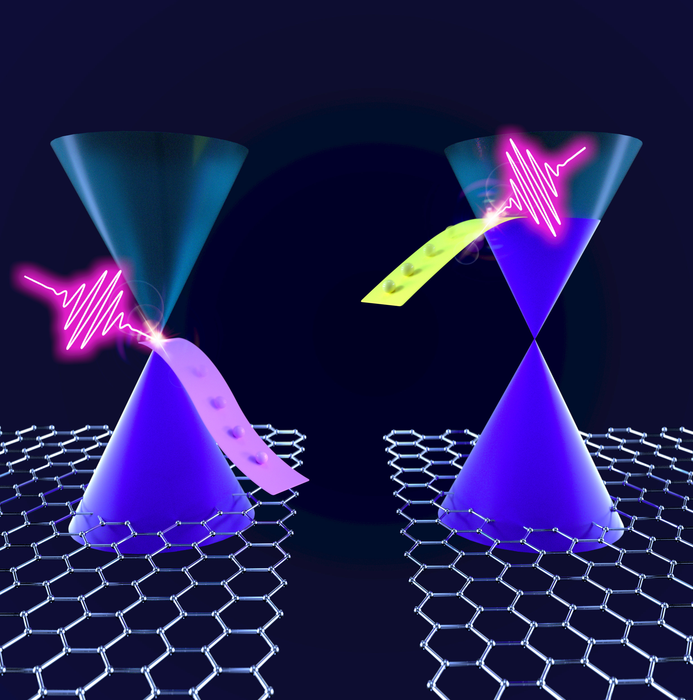With the thickness of a single atomic layer, graphene is the thinnest material ever produced. Thinner than a billionth of a meter, graphene can absorb light efficiently from the visible to the infrared via the photoexcitation of its charge carriers.
 Graphene charge carriers lying on different energetic levels represented by the Dirac cones, which, depending on the number of charge carriers, are occupied up to the neutrality point (blue level on the left cone) or well into the conduction band (blue level on the right cone). In the two cases, the photoexcited charge carriers relax with faster (left side) or slower (right side) dynamics. Image Credit: Politecnico di Milano–CNR.
Graphene charge carriers lying on different energetic levels represented by the Dirac cones, which, depending on the number of charge carriers, are occupied up to the neutrality point (blue level on the left cone) or well into the conduction band (blue level on the right cone). In the two cases, the photoexcited charge carriers relax with faster (left side) or slower (right side) dynamics. Image Credit: Politecnico di Milano–CNR.
Once light absorption occurs, its photoexcited charge carriers get cooled down to the initial equilibrium state in a few picoseconds, which corresponds to a millionth of a millionth of a second. The relaxation process’ extraordinary speed makes graphene especially capable for several technological applications, such as light detectors, sources and modulators.
The current study was conceived within a global collaboration between the CNR-IFN, Politecnico di Milano, the University of Pisa, the Graphene Center of Cambridge (UK), and ICN2 of Barcelona (Spain), and it was published in the journal ACS Nano.
The change in the relaxation time of charge carriers in graphene that we have observed demonstrates an unprecedented level of control on the optical response of a crystal and allows to obtain a large variety of behaviors using a single material.
Eva Pogna, Study First Author and Researcher, Consiglio Nazionale delle Ricerche
This study paves the way to the design of devices that use the control of the relaxation time of charge carriers to support new functions. For instance, the duration of the output pulses can be controlled if graphene is utilized as a saturable absorber in a laser cavity to produce ultrashort light pulses, by altering the relaxation time of the charge carriers.
The specific device that we have used to study graphene, proved to be crucial to observe the strong tunability of its optical properties with the external electric field, allowing to change the number of charge carriers over a broad range by exploiting ionic liquid gating, which is a state-of-the-art technology introduced to study superconductors.
Andrea Ferrari, Director, Cambridge Graphene Centre
The graphene-based device has been studied with ultrafast spectroscopy, which enables the changes of the relaxation time of the charge carriers to be monitored.
This work represents the latest step of a long-standing research collaboration devoted to the study of the ultrafast carrier dynamics in graphene, aimed at exploring the great potential of this fascinating material.
Klaas-Jan Tielrooij, Leader, Ultrafast Dynamics, Nanoscale Systems Group, ICN2
“This discovery is of large interest for a number of technological applications, ranging from photonics, for pulsed laser sources or optical limiters that prevent optical components damaging, to telecommunication, for ultrafast detectors and modulators,” says Giulio Cerullo, professor of the Physics Department of Politecnico di Milano.
Journal Reference:
Pogna, E. A. A., et al. (2022) Electrically Tunable Nonequilibrium Optical Response of Graphene. ACS Nano. doi.org/10.1021/acsnano.1c04937.